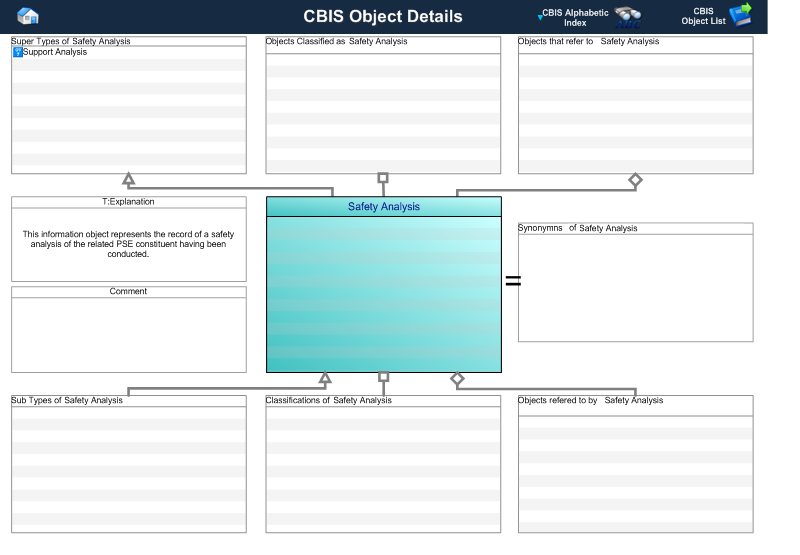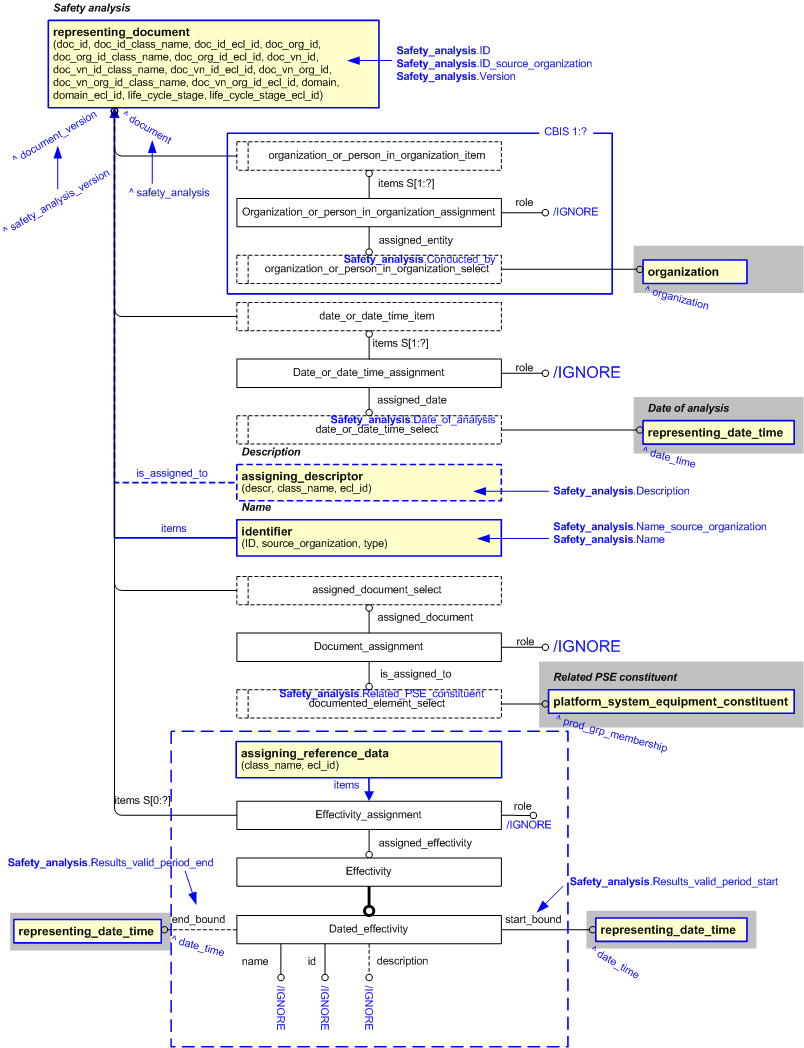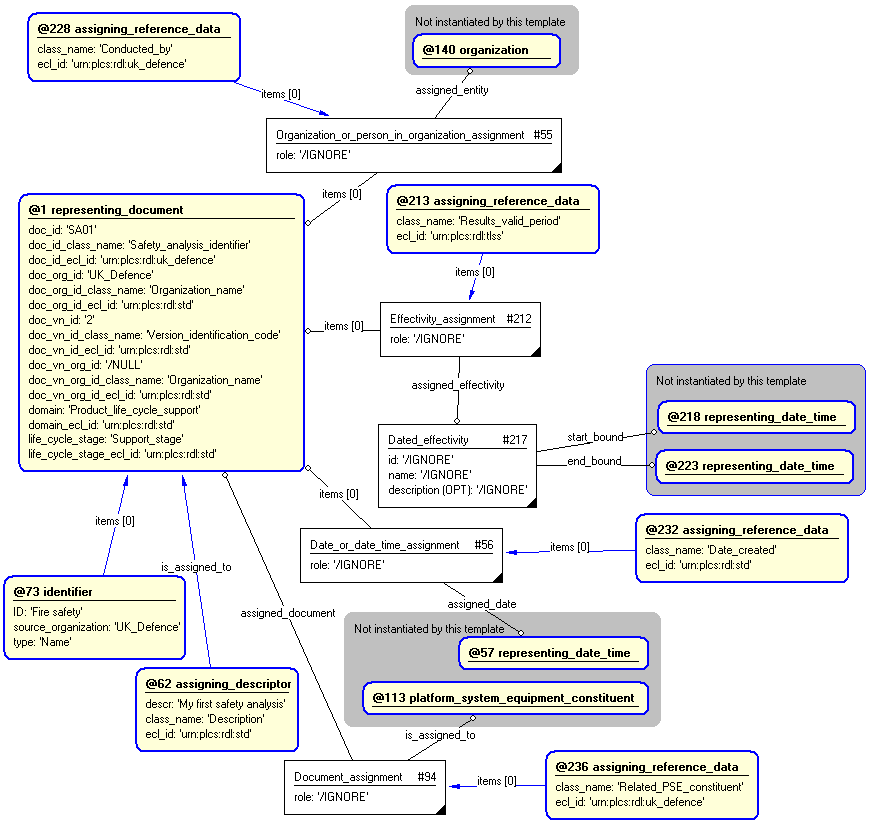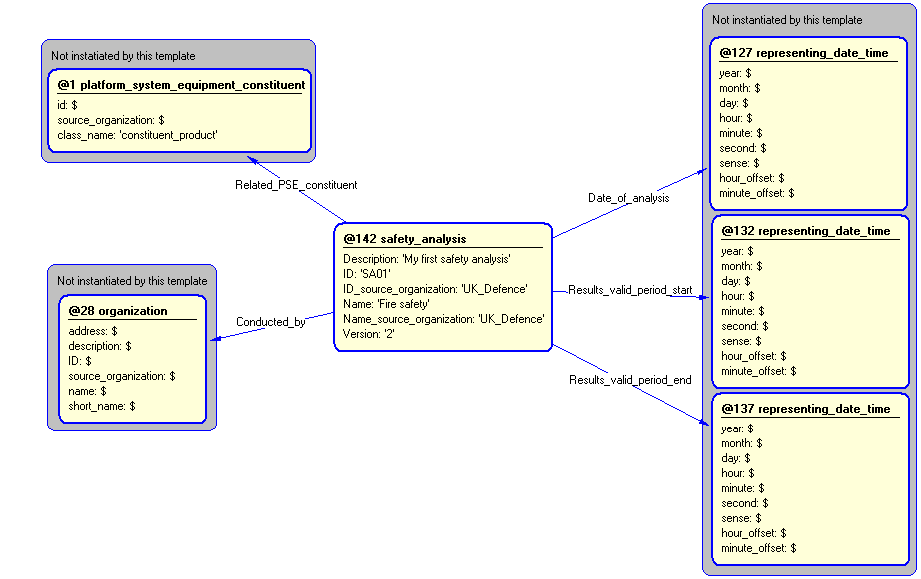Template:— safety_analysis (sfty_anl)
Context:— UK_Defence |
Date: 2010/03/15 15:08:44
Revision: 1.4
|
This section specifies the template safety_analysis.
NOTE
The template has been defined in the context of
UK_Defence.
Refer to the business context for details of related templates.
NOTE
An explanation of a template and the associated instantiation path is
provided in the
Template overview
section.
This template describes how to represent the UK_Defence concept of a safety analysis in terms of PLCS
model elements (templates, entities, and reference data).
This information object represents the record of an analysis process having been conducted.
Subtypes of this object type record specific types of analyses.
The results of each safety analysis are recorded by means of relationships from the information objects that are generated
by the analysis and the safety analysis object itself.
The EXPRESS-G diagram in
Figure
2
shows the templates and EXPRESS entities that are required
to represent the template
"safety_analysis".
The text highlighted in blue shows the template parameters.
Figure 2 — An EXPRESS-G representation of the Information model for safety_analysis
The graphic for the template to be used in other EXPRESS-G diagrams
is shown in Figure
3
below.
Figure 3 — The graphical representation of the safety_analysis template
The following input parameters are defined for this template:
The reference to the person or organization that conducted the safety analysis.
The reference to the date and time on which the safety analysis was conducted.
The description of the safety analysis.
If this attribute is not required, the relevant
assigning_descriptor template should not be instantiated.
The identifier of the safety analysis.
The identifier of the organization responsible for identifying the safety analysis.
Name (Type='STRING', Optional)
The name of the safety analysis.
The name of the organization responsible for identifying the safety analysis.
The reference to the constituent of the platform system equipment that is the subject of the safety analysis.
The version of the safety analysis.
The following reference parameters are defined for this template:
Allow the
Document
entity instantiated in this path to be referenced when this template is used.
Note: The
Document
entity can be referenced in a template path by:
%^target = $safety_analysis.safety_analysis%
where
target
is the parameter to which the
Document
is bound.
Allow the
Document_version
entity instantiated in this path to be referenced when this template is used.
%^target = $safety_analysis.safety_analysis_version%
The instantiation path shown below specifies the entities that are to be
instantiated by the template.
A description of templates and the syntax for the instantiation path is
provided in the
Templates Help/Information section.
-- Representing document /
representing_document(
doc_id=@ID,
doc_id_class_name='Safety_analysis_identifier',
doc_id_ecl_id='urn:plcs:rdl:uk_defence',
doc_org_id=@ID_source_organization,
doc_org_id_class_name='Organization_name',
doc_org_id_ecl_id='urn:plcs:rdl:std',
doc_vn_id=@Version,
doc_vn_id_class_name='Version_identification_code',
doc_vn_id_ecl_id='urn:plcs:rdl:std',
doc_vn_org_id='/NULL',
doc_vn_org_id_class_name='Organization_identification_code',
doc_vn_org_id_ecl_id='urn:plcs:rdl:std',
domain='Through_life_support_standard',
domain_ecl_id='urn:plcs:rdl:uk_defence',
life_cycle_stage='Support_stage',
life_cycle_stage_ecl_id='urn:plcs:rdl:std')/
%^safety_analysis = $representing_document.document%
%^safety_analysis_version = $representing_document.document_version%
-- Create relationship to conducting organization Organization_or_person_in_organization_assignmentOrganization_or_person_in_organization_assignment.items ->
^safety_analysis
Organization_or_person_in_organization_assignment.assigned_entity ->
@Conducted_byOrganization_or_person_in_organization_assignment.role = '/IGNORE'
%^org_assignment =
Organization_or_person_in_organization_assignment%
/
assigning_reference_data(
class_name='Conducted_by',
ecl_id='urn:plcs:rdl:uk_defence',
items=^org_assignment)/
-- Date of analysis Date_or_date_time_assignmentDate_or_date_time_assignment.role = '/IGNORE'
Date_or_date_time_assignment.items ->
^safety_analysis
Date_or_date_time_assignment.assigned_date ->
@Date_of_analysis%^date_assignment =
Date_or_date_time_assignment%
/
assigning_reference_data(
class_name='Date_created',
ecl_id='urn:plcs:rdl:uk_defence',
items=^date_assignment)/
-- [optional Description] /
assigning_descriptor(
descr=@Description,
class_name='Description',
ecl_id='urn:plcs:rdl:std',
is_assigned_to=^safety_analysis)/
-- Name /
identifier(
ID=@Name,
source_organization=@Name_source_organization,
type='Name',
items=^safety_analysis)/
-- Related PSE constituent Document_assignmentDocument_assignment.role = '/IGNORE'
Document_assignment.assigned_document ->
^safety_analysis
Document_assignment.is_assigned_to ->
@Related_PSE_constituent%^doc_assignment =
Document_assignment%
/
assigning_reference_data(
class_name='Related_PSE_constituent',
ecl_id='urn:plcs:rdl:uk_defence',
items=^doc_assignment)/
-- Results Valid Period Dated_effectivityDated_effectivity.id = '/IGNORE'
Dated_effectivity.name = '/IGNORE'
Dated_effectivity.description = '/IGNORE'
Dated_effectivity.start_bound ->
@Results_valid_period_startDated_effectivity.end_bound ->
@Results_valid_period_end%^dated_effectivity =
Dated_effectivity%
Effectivity_assignmentEffectivity_assignment.role = '/IGNORE'
Effectivity_assignment.items ->
^safety_analysis
Effectivity_assignment.assigned_effectivity ->
^dated_effectivity
%^effectivity_assignment =
Effectivity_assignment%
/
assigning_reference_data(
class_name='Results_valid_period',
ecl_id='urn:plcs:rdl:std',
items=^effectivity_assignment)/
The following entities are instantiated with attributes as specified:
The instance diagram in Figure
4
shows an example of the EXPRESS entities and templates that are instantiated by the template:
/safety_analysis(Conducted_by='#cb', Date_of_analysis='#da', Description='My first safety analysis', ID='SA01', ID_source_organization='UK_Defence', Name='Fire safety', Name_source_organization='UK_Defence', Related_PSE_constituent='#PSE', Results_valid_period_start='#sd', Results_valid_period_end='#ed', Version='2')/
(an illustration of the consolidated safety_analysis template is shown in
Figure
5 below.)
Figure 4 — Entities instantiated by safety_analysis template
The instance diagram in
Figure
5
shows the graphic symbol for the template that is to be
used in other instance diagrams. The example template is:
/safety_analysis(Conducted_by='#cb', Date_of_analysis='#da', Description='My first safety analysis', ID='SA01', ID_source_organization='UK_Defence', Name='Fire safety', Name_source_organization='UK_Defence', Related_PSE_constituent='#PSE', Results_valid_period_start='#sd', Results_valid_period_end='#ed', Version='2')/
Figure 5 — Instantiation of safety_analysis template
Characterizations
No common characterizations of the template
safety_analysis
have been identified. However, the ISO 10303-239 EXPRESS model
may enable other assignments to the entities instantiated by the template.





